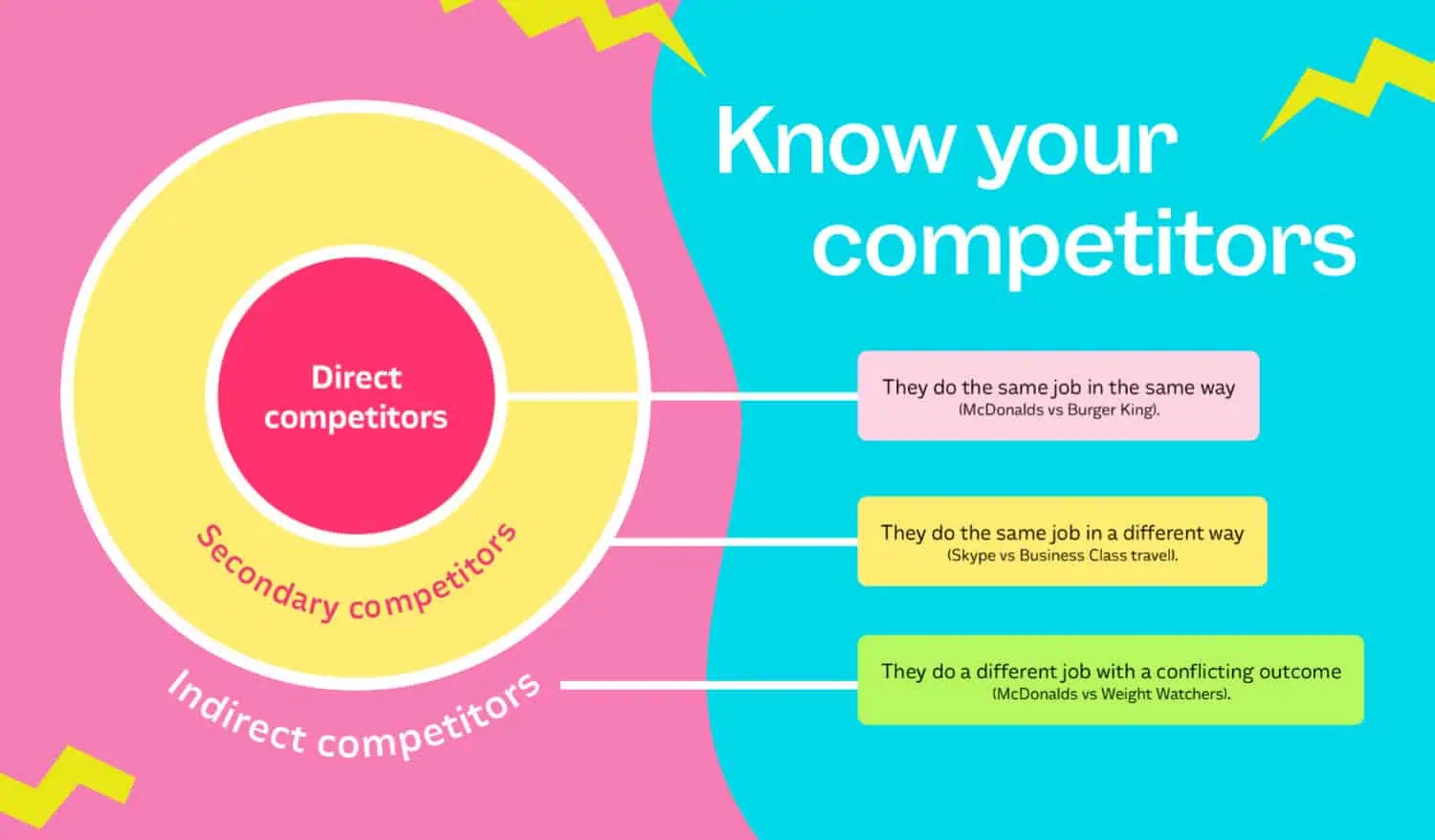Doing a competitor swot analysis is crucial for any business that wants to understand its market landscape and improve its strategies. A SWOT analysis examines the strengths, weaknesses, opportunities, and threats relevant to a company.
Steps to perform a thorough swot analysis of competitors –
- Step 1: Identify Your Main Competitors
- Step 2: Gather Information on Competitors
- Step 3: Analyze Each Competitor’s Strengths, Weaknesses, Opportunities, and Threats
- Step 4: Identify Competitive Advantages
- Step 5: Anticipate Competitor Responses
You gain valuable insights into their positioning and strategies through a SWOT analysis of key competitors. Read on for a step-by-step guide on conducting an effective competitor analysis swot.
Competitor SWOT Analysis: History
SWOT is the complete form of Strengths, Weaknesses, Opportunities, and Threats. A SWOT analysis evaluates a company, project, product, or person using a framework. Internal strengths, weaknesses, and external opportunities and threats are identified. A SWOT analysis assesses the strategic position of an organization or individual to guide decision-making and planning.
Read also: Lego SWOT Analysis: Building Blocks of Success
Why is conducting a SWOT analysis on your competitors important?
Step 1: Identify Your Main Competitors
Firstly, identify who your main competitors are. These companies should offer your target customers similar products or services. You should look at direct and indirect competitors.
Direct competitors provide nearly identical offerings, while indirect ones offer alternatives that satisfy the same customer needs. Get as comprehensive a list as possible to view your competitive landscape fully.
Ways to identify competitors
- Searching online directories and market research reports of companies in your industry
- Looking at who your existing customers were buying from before
- Seeing who your sales and marketing teams view as main competitors
- Checking which competitor brands key industry sites and publications mention most frequently as major players
- Asking customers who they view as the key alternatives to your offerings.
Take the time to research and create an exhaustive list of all potential direct and indirect competitors. Then, select the 5-10 biggest competitors who pose the greatest threat or have similar offerings to your company to analyze in depth.
Step 2: Gather Information on Competitors
The next step is to gather detailed information on your key competitors. It gives you insights into the strength of competitors and strategies. Useful sources of competitor intelligence include:
- The competitors’ websites: Study their products/services, pricing, messaging, and branding.
- Marketing collateral like brochures, ads, case studies, and webinars
- Publicly available financial reports and funding information
- Industry reports, news sites, and press releases related to the competitors
- Job postings that give clues about new products or initiatives
- Customer review sites to see feedback on competitors’ offerings.
- Social media activity of the competitor companies for promotions and announcements
Spend time gathering data from these sources to create competitor profiles.
Step 3: Analyze Each Competitor
With competitor information gathered, you can now research your competitor’s swot analysis in-depth. Make sure to use the SWOT framework:
Strengths
What are some unique strengths and core capabilities of this competitor? Some examples include:
- Established brand reputation and customer loyalty
- Superior product quality or features
- Competitive pricing and discounts
- Strong marketing and sales processes
- Robust supply chain and operations
- Financial assets and backing
Weaknesses
What are some potential deficiencies or gaps of the competitor?
- Lack of brand awareness in the market
- Weak customer support and service levels
- Limited distribution network
- Higher prices than competitors
- Negative customer feedback and reviews
- Underperforming sales and marketing strategies
Opportunities
What current trends or conditions can the competitor leverage for growth? Look at things like…
- Developing new innovative products or features
- Expanding into new geographical markets
- Building partnerships and integrations
- Moving into new customer segments
- Investing more in digital marketing and e-commerce
Threats
What external factors or challenges might hinder the competitor? For example:
- Loss of major customers
- The emergence of disruptive technologies
- Government regulations and policies
- Slowing growth in their overall market category
- Changing consumer preferences and lifestyles
- Aggressive pricing from new market entrants
Analyzing competitive threats helps anticipate challenges and position against them.
Step 4: Identify Competitive Advantages
With the SWOT analysis complete, you have to focus on the ”competitor” part of the competitor swot analysis. You can now spot your biggest advantages and points of differentiation compared to each player. Identify strengths or capabilities that are:
- Hard to mimic quickly by competitors
- Critical to customer purchasing criteria
- Unique in the market
- Aligned with industry trends and developments
These become the key competitive edges that set you apart. Communicate these differentiators strongly in your marketing.
Step 5: Anticipate Competitor Responses
The final step is anticipating competitors’ adjustments if you gain an edge. For example:
- Lower prices if you undercut on cost
- Enhance features if you launch an innovation first
- Imitate your marketing messages if you resonate better with customers
- Expand to your geographical markets if you enter a new region
Anticipating the likely threat of competitors’ moves allows you to plan effective countermeasures. It keeps you ahead of the competition.
Following all the above steps, you can perform your competitor’s swot analysis. It is a critical part of your strategy to help you succeed against rivals.
Check this out: Retail SWOT Analysis: Things to Know About the Retail Industry
Frequently Asked Questions
What does a competitor SWOT analysis offer in terms of benefits?
There are numerous benefits. Completing a competitor SWOT analysis helps you identify your competitors' strengths so you can prepare for them and defend against those strengths. It also reveals any vulnerabilities or weaknesses in your competitors that you may take advantage of. Valuable insights into your competitors' strategies and direction are gained, guiding your strategy.
Does competitor analysis only involve SWOT analysis?
No, while competitor SWOT analysis provides essential insights, competitor analysis goes beyond just identifying strengths, weaknesses, opportunities, and threats. It may also involve analyzing competitors' marketing strategies, pricing, product offerings, customer segments, revenues, profitability, growth rate, etc.
How often should I review my competitor analysis?
The passage recommends reviewing your competitive analysis every 6 to 12 months as market dynamics change. Regular reassessment ensures your strategy remains relevant and up-to-date.
Final Words
Completing a thorough competitor swot analysis certainly provides many benefits. It helps you identify the strengths you need to watch out for and reveals any weaknesses you can exploit. You will also acquire an understanding of the strategies of your competitors and direction. It can show any gaps or needs your competitors are not currently satisfying.
Carrying out this analysis allows you to benchmark your performance against your competitors and position yourself as a better option in customers’ minds compared to the competition. And make sure to revisit your competitive analysis every year or half a year as market dynamics change.
Read also: How to Do SWOT Analysis of a Leader?









